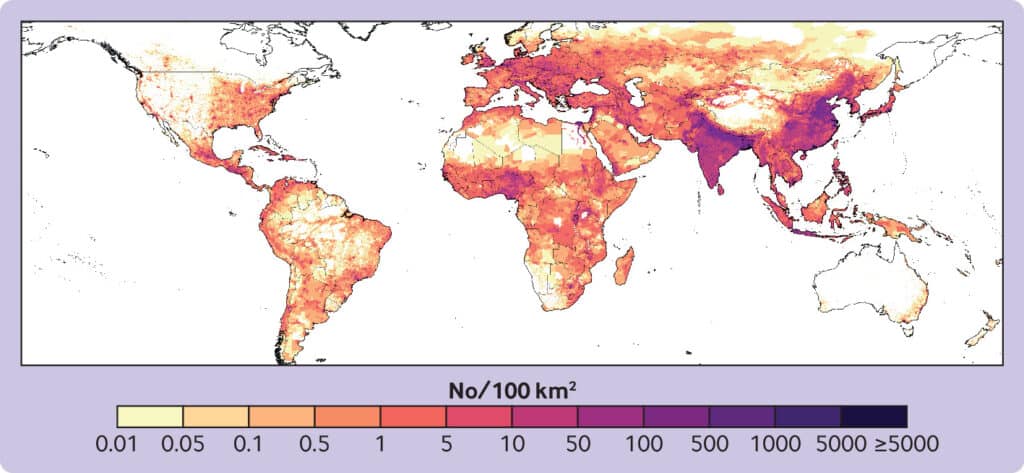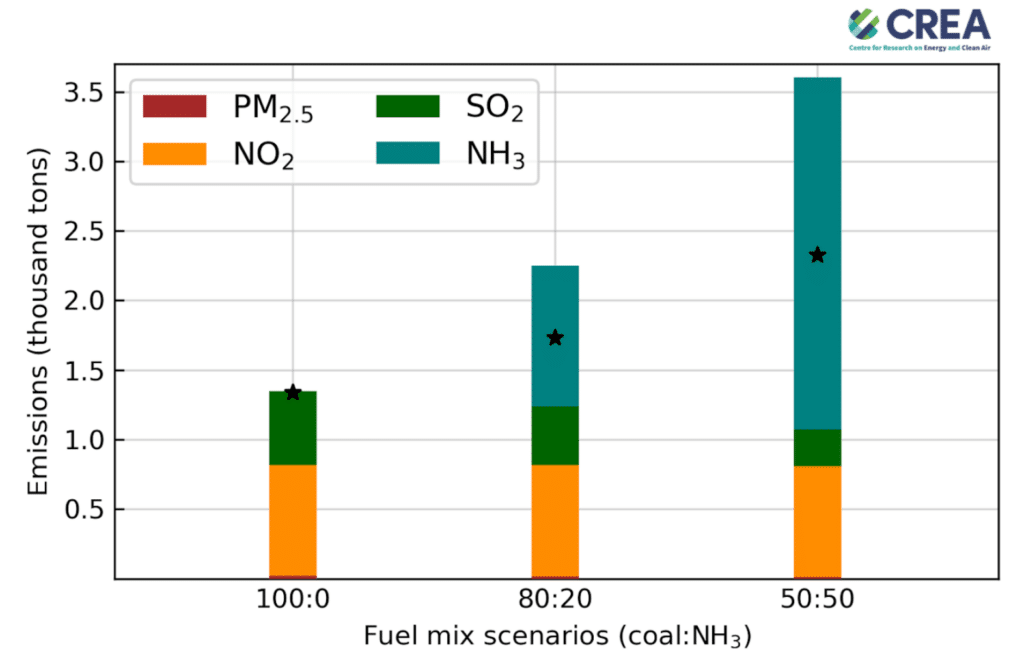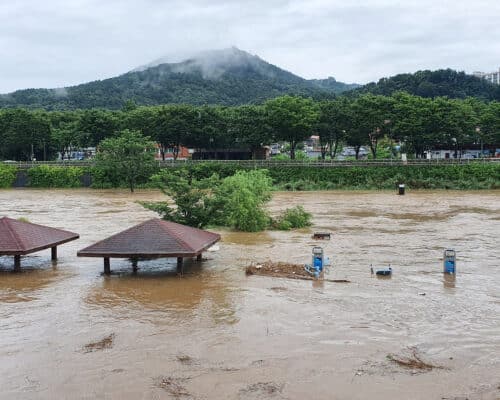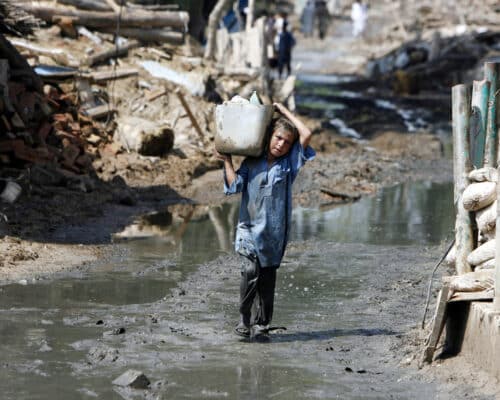Ammonia-Coal Co-firing Plans Risk Worsening the Air Quality Problem in India and Pakistan
08 April 2024 – by Viktor Tachev
Cities across India and Pakistan often top the charts for the worst air quality in the world, and fossil fuels are at the centre of the problem. At a time when both countries should prioritise decommissioning fossil fuel-powered plants, there are proposals to extend their lives by investing in ammonia-coal co-firing schemes and other fossil fuel-based technologies. The latest scientific research reveals that such solutions, which experts and academics describe as “false”, will further exacerbate the problem of bad air quality.
The Ammonia-Coal Co-firing Projects in India and Pakistan
In 2022, under the International Demonstration Project on Japan’s Energy Efficiency Technologies, India’s Adani Power and Japanese partners announced pilot projects for 20% ammonia co-firing at their Mundra Plant, India’s largest private-sector power plant. If successful, the companies plan to transition to 100% ammonia “mono-firing” also at several other power plant sites.
Compared to its Southeast Asian peers, India’s ammonia co-firing plans aren’t as ambitious. However, there is a chance that more developments will come in the future under the India-Japan Clean Energy Partnership. Furthermore, India plans to significantly expand its coal fleet and add up to 88 GW of thermal capacity by 2032. Considering that it aims to achieve net zero by 2070, the new capacity might also be switched to ammonia co-firing or equipped with carbon capture and storage (CCS) technology at some point to align with the nation’s decarbonisation plans.
Pakistan hasn’t officially announced ammonia co-firing projects in its pipeline. However, according to the IEEFA, the possibility of co-firing ammonia in existing thermal power plants exists. A move like this would signal that the country is looking to wean itself off coal power but also wants to give its coal plants a “second life” through investments in coal-to-liquid and coal-to-gas processes.
Air Quality Problems in India and Pakistan
Between 2017 and 2022, 47 of the top 50 cities with the worst air quality were in Asia. Cities in India and Pakistan topped the charts.
In 2023, 83 of the top 100 most polluted cities were in India. Furthermore, all exceeded the World Health Organisation’s air quality guidelines by over ten times.
According to IQAir’s 2023 Air Quality report, the average concentration of PM 2.5 in Pakistan in 2023 was 73.7 micrograms per cubic metre. In New Delhi, India, it was 92.7. For reference, the WHO’s air quality guidelines recommends no more than 5 micrograms per cubic metre.
According to a Chicago University study, people living in Delhi lose 12 years of life due to air pollution. For reference, the country’s average is five years of life lost. In Pakistan’s most polluted regions, including Lahore, Sheikhupura, Kasur, and Peshawar, air pollution shortens lives by almost seven years.
Scientific research reveals that South and East Asia have the highest numbers of deaths due to long-term exposure to air pollution, including ambient fine particulate matter (PM2.5) and ozone (O3). Scientists note that these deaths could potentially be avoided by phasing out fossil fuels.

Outdoor air pollution causes over 2 million deaths per year in India, while the number of lives lost due to exposure to PM2.5 is increasing every year. In Pakistan, at least 128,000 annual deaths are attributed to air pollution.

Ammonia Co-firing and CCS Risk Worsening the Air Quality Problem in Both Countries
Investments in co-firing technologies and CCS will further extend the lives of fossil fuel plants, locking countries into extended air pollution. Furthermore, the proposed technologies are also found to be polluting.
A Center for Research on Energy and Clean Air (CREA) study finds that displacing coal with ammonia substantially increases total pollutant emissions. For example, a 20% ammonia co-firing combustion rate can increase PM2.5 and other harmful substances by 67%. At a 50% co-firing rate, the increase is 167%.
Long-term exposure to PM2.5 leads to various adverse health conditions. According to the State of Global Air, they include ischemic heart attacks, lung cancer, respiratory infections, stroke, Type 2 diabetes, and adverse birth outcomes such as autism.
Aside from PM2.5, ammonia co-firing produces other harmful emissions, including sulfur dioxide, nitrogen dioxide and more. It also poses a water contamination risk.
CCS and Ammonia-Coal Co-firing Plans Threaten the Decarbonisation Progress of India and Pakistan
Proposals for using CCS and ammonia-coal co-firing come mainly as a result of Japan’s Green Transformation Strategy (GX). It plans to export these technologies across Asia through the Asia Zero Emissions Community (AZEC) and the Asia Energy Transition Initiative (AETI).
However, experts describe these solutions as “false” and “a way to legitimise coal in the eyes of financiers and lenders”. The solutions’ fossil fuel nature risks impeding instead of accelerating the clean energy transition in the region.
According to the Breakthrough Institute, ammonia and hydrogen co-firing schemes may result in more emissions than simply burning coal or gas.
TransitionZero finds that Japan’s goal of 20% ammonia co-firing at domestic coal power plants by 2030 will still generate nearly double the emissions of standard gas-fired power plants. In Southeast Asian countries, the figures are even higher. Even 50% ammonia co-firing schemes would emit comparable emissions to gas power generation.

BloombergNEF warns that even green ammonia-based scenarios won’t align with a net-zero power sector. This is important for India. The country aims to become a global leader in green ammonia production and has already struck export agreements with Japanese utilities, which plan to use green ammonia for power generation and other purposes.
CCS projects, on the other hand, face efficiency challenges. Although most projects claim to remove around 85-95% of carbon emissions, Stanford scientists estimate that the actual efficiency can be as low as 10- 11%. Other studies point out even lower figures, like 7%.
India and Pakistan are in dire need of immediate CO2 emissions reduction not only to achieve their climate targets but to avoid the worst impacts of the climate crisis.
Pakistan is the seventh most vulnerable country to climate change. According to the State of India’s Environment Report 2022, India is the fourth worst-hit country by climate change.
Both Pakistan and India have experienced increased heat stress in recent years, with devastating heat waves breaking historical records in various regions. In addition, the countries also experienced extreme floods. Both types of events are found to be significantly exacerbated by climate change.
Phasing Out Fossil Fuels Crucial For India and Pakistan
Phasing out fossil fuels is the single solution to India and Pakistan’s most pressing problems: decarbonisation, climate change and air pollution. However, technologies like ammonia co-firing and CCS promise to do the exact opposite. Adopting these technologies for power generation risks blocking the renewable energy transition. Furthermore, this can undermine energy security and worsen the climate and air pollution crises. As scientists warn, the impacts on the 1.65 billion people that India and Pakistan are home to can be severe.
by Viktor Tachev
Viktor has years of experience in financial markets and energy finance, working as a marketing consultant and content creator for leading institutions, NGOs, and tech startups. He is a regular contributor to knowledge hubs and magazines, tackling the latest trends in sustainability and green energy.
Read more








